| Ban of Croatia | |
|---|---|
| Hrvatski ban | |
 The heraldic standard of the Croatian ban in the 19th century | |
| Reports to | King of Croatia Croatian Parliament |
| Seat | Banski dvori, Zagreb, Croatia |
| Term length | No fixed term length |
| Formation | c. 949 |
| First holder | Pribina |
| Final holder | Ivan Šubašić |
| Abolished | 10 April 1941 (de facto) 13 June 1943 (de jure) |
| History of Croatia |
|---|
 |
| Timeline |
|
|
| Part of a series on |
| Great Officers of State in the Kingdom of Hungary |
|---|
.svg.png.webp) |
| Kingdom of Hungary |
Ban of Croatia (Croatian: Hrvatski ban) was the title of local rulers or office holders and after 1102, viceroys of Croatia. From the earliest periods of the Croatian state, some provinces were ruled by bans as a ruler's representative (viceroy) and supreme military commander. In the 18th century, Croatian bans eventually became the chief government officials in Croatia.
They were at the head of the Ban's Government, effectively the first prime ministers of Croatia. The institution of ban persisted until the first half of the 20th century, when it was officially superseded in function by that of a parliamentary prime minister.
Origin of title
South Slavic ban (Croatian pronunciation: [bâːn], with a long [a]), is directly attested in 10th-century Constantine Porphyrogenitus' book De Administrando Imperio as βο(ε)άνος, in a chapter dedicated to Croats and the organization of their state, describing how their ban "has under his rule Krbava, Lika and Gacka."[1]
Bans during the Trpimirović dynasty
References from the earliest periods are scarce, but history recalls that the first known Croatian ban is Pribina from the 10th century. In the early Middle Ages, the ban was the royal district governor of Lika, Gacka and Krbava. Later, the meaning of the title was elevated to that of provincial governor in the Kingdom of Croatia. King Demetrius Zvonimir was originally a ban serving under King Peter Krešimir IV.
| Name (Birth–Death) |
Term start | Term end | Notes | Monarch (Reign) |
|---|---|---|---|---|
| Pribina | c. 949 |
c. 969 |
The first historically attested Ban of Croatia. Pribina deposed of King Miroslav during a civil war in the Croatian Kingdom, and replaced him with Michael Krešimir. He ruled over the Gacka, Krbava and Lika counties, according to De Administrando Imperio. He is also possibly referred to in a charter as potens banus, meaning "powerful ban".[2] | Miroslav (945–949) |
Michael Krešimir II (949–969) | ||||
| Godemir | c. 969 |
c. 997 |
Also called Godimir. He is mentioned to have served kings Michael Krešimir and Stephen Držislav[3] in a charter of King Peter Krešimir IV the Great from 1068.[4] | |
Stephen Držislav (969–997) | ||||
| Gvarda | c. 997 |
c. 1000 |
Mentioned in a charter of King Peter Krešimir IV the Great from 1068. | |
Svetoslav Suronja (997–1000) | ||||
| Božeteh | c. 1000 |
c. 1030 |
Mentioned in a charter of King Peter Krešimir IV the Great from 1068. | |
| Stephen Praska | c. 1035 |
c. 1058 |
According to the chronicle of Archdeacon Goricensis John, he was named as ban by King Stephen I around 1035 (after his military expeditions to the east), thus succeeding Božeteh as Croatian ban.[5][6][7] He eventually attained a Byzantine imperial title of protospatharios somewhere between 1035 and 1042, which governed his influence over the Dalmatian theme. | Stephen I (1030–1058) |
| Gojčo | c. 1059 |
c. 1069 |
He was possibly the brother of King Peter Krešimir IV the Great, who was rumored to have murdered his other brother called Gojslav.[8] | Peter Krešimir IV (1058–1074) |
| Demetrius Zvonimir | c. 1070 |
c. 1075 |
During the reign of Peter Krešimir IV (Zvonimir's relative), Demetrius Zvonimir ruled in Slavonia, specifically the land between the rivers Drava and Sava, with the title of ban.[9] Croatian charters at the time were issued in the names of both King Peter Krešimir and Ban Zvonimir.[10] In 1074, Normans from southern Italy invaded Croatia and captured a certain Croatian ruler whose name is not known, certainly King Peter Krešimir, who died soon after and was succeeded by Demetrius Zvonimir.[11] | |
| Petar Snačić | c. 1075 |
c. 1091 |
Ban of Croatia according to a later addenda to Supetar Cartulary. | Demetrius Zvonimir (1075–1089) |
Stephen II (1089–1091) |
Croatian bans after 1102
After the Croats elected King Coloman of Hungary as King of Croatia 1102, the title of ban acquired the meaning of viceroy. Bans were appointed by the Hungarian king as his representatives in Kingdom of Croatia, heads of the parliament (sabor) and also as supreme commander of Croatian Army.
Croatia was governed by the viceregal ban as a whole from 1102 until 1225, when it was split into two separate regions of Slavonia and Croatia. Two different bans were occasionally appointed until 1476, when the institution of a single ban was resumed. Most bans were native nobles but some were also of Hungarian ancestry.
Most notable bans from this period were Pavao Šubić and Peter Berislavić.
Bans of Croatia, Slavonia and Dalmatia
| Portrait | Name (Birth–Death) |
Term start | Term end | Notes | Monarch (Reign) |
|---|---|---|---|---|---|
| Ugra | 1102 | 1105 | Coloman (1102–1116) | ||
| Sergije | 1105 | ||||
| Klaudije | 1116 | 1117 | Stephen II (1116–1131) | ||
| Aleksije | c. 1130 | c. 1141 | Béla II (1131–1141) | ||
| Beloš (1083–1163) |
1142 | c. 1158 | Géza II (1141–1162) | ||
| Apa | 1158 | ||||
| Beloš (1083–1163) |
1163 | Stephen III (1162–1172) | |||
| Ampudije | 1164 | c. 1180 | |||
| Mauro | 1181 | Béla III (1172–1196) | |||
| Denis | c. 1180 | c. 1183 | Ban only in the littoral part | ||
| Suban | 1183 | 1185 | |||
| Kalán (c. 1152–1218) |
1190 | 1193 | |||
| Dominic Miskolc | 1194 | c. 1195 | |||
| Andrija | 1198 | for Duke Andrew | Emeric (1196–1204) | ||
| Nicholas I of Transylvania | 1198 (?) | 1199 | for King Emeric | ||
| Benedict Osl | 1199 | 1200 | for King Emeric | ||
| Nicholas, Palatine of Hungary | 1200 | 1201 (?) | for Duke Andrew | ||
| Martin Hont-Pázmány | 1202 | for Duke Andrew | |||
| Hipolit | 1204 | for King Emeric | |||
| Mercurius | 1205 | 1206 | Ladislaus III (1204–1205) | ||
| Stephen Mihaljev | 1206 | 1207 | Andrew II (1205–1235) | ||
| Bánk Bár-Kalán | 1208 | 1209 | |||
| Tomo | 1209 | ||||
 |
Berthold | 1209 | 1211 | ||
| Michael Kačić | 1212 | ||||
| Martin Hont-Pázmány | 1213 | ||||
| Julius I Kán | 1213 | ||||
| Simon Kačić | 1212 | 1214 | |||
| Ohuz | 1214 | ||||
| Ivan | 1215 | 1216 | Ban only in Slavonia | ||
| Pontius of Cross | 1217 | ||||
| Bánk Bár-Kalán | 1217 | 1218 | |||
| Julius I Kán | 1218 | 1219 | |||
| Ernej | 1220 | 1221 | |||
| Ohuz | 1219 | 1220 | |||
| Solomon Atyusz | c. 1222 | c. 1225 | |||
Bans of Croatia and Dalmatia
From 1225 to 1476, there were parallel Bans of Croatia and Dalmatia and of "Whole Slavonia". The following is the list of the former, the latter are listed at the article Ban of Slavonia. During the period of separate titles of ban, several persons held both titles, which is indicated in the notes.
After the death of King Louis I of Hungary, his daughter Mary succeeded to the throne, which led to kings Charles III and Ladislaus of Naples claiming the Kingdom of Hungary. A war erupted between forces loyal to Mary, and later to her husband and successor Sigismund of Luxembourg, and those loyal to Ladislaus.
During this time, Sigismund appointed Nicholas II Garai (who was also count palatine) the Ban of Croatia and Dalmatia in 1392, Butko Kurjaković in 1394, and then again Garai in the period from 1394 to 1397. Nicholas II Garai was also at the time the Ban of Slavonia, succeeded by Ladislav Grđevački (1402–1404), Paul Besenyő (1404), Pavao Peć (1404–1406), Hermann II of Celje (1406–1408).
Ladislaus in turn appointed his own bans. In 1409, this dynastic struggle was resolved when Ladislaus sold his rights over Dalmatia to the Republic of Venice.
| Portrait | Name (Birth–Death) |
Term start | Term end | Notes | Monarch (Reign) |
|---|---|---|---|---|---|
| Vojnić | 1225 | Andrew II (1205–1235) | |||
| Valegin | 1226 | ||||
| Stephen IV Babonić | 1243 | 1249 | Béla IV (1235–1270) | ||
| Butko of Podgorje | 1259 | ||||
| Stephen of Klis | 1263 | 1266 | |||
| Nicholas of Gacka | 1275 | Son of Amadeus Aba | Ladislaus IV (1272–1290) | ||
 |
Pavao I Šubić | 1278 | 1312 | ||
Andrew III (1290–1301) | |||||
| Charles I (1301–1342) | |||||
| Mladen II Šubić | 1312 | 1322 | |||
| Stephen I Lackfi | 1350 | 1352 | Louis I (1342–1383) | ||
| Ivan Ćuz | 1356 | 1358 | |||
 |
Nicholas Szécsi | 1358 | 1366 | ||
| Kónya Szécsényi | 1366 | 1367 | |||
| Emeric I Lackfi | 1368 | ||||
| Simon Mauritius of Pok | 1369 | 1371 | |||
.jpg.webp) |
Charles of Durazzo | 1371 | 1376 | ||
 |
Nicholas Szécsi | 1377 | 1380 | Second term | |
 |
Emeric I Bebek | 1380 | 1383 | ||
._-Keszthely%252C_2016_Hungary.jpg.webp) |
Stephen II Lackfi | 1383 | 1384 | Mary (1382–1395) | |
| Thomas of St George | 1384 | 1385 | |||
 |
Ivan Paližna | 1385 | 1386 | Co-ruled with relative Ivan Anjou Horvat (1385–1387). Also at the time the Ban of Slavonia. | |
| Ladislaus Lackfi | 1387 | ||||
| Denis of Lučenec | 1387 | 1389 | |||
 |
Ivan Paližna | 1389 | Second term. Also at the time the Ban of Slavonia. | ||
| Butko Kurjaković | 1394 | ||||
| Nicholas II Garai | 1395 | 1397 | Charles II (1385–1386) | ||
 |
Hermann II of Celje | 1406 | 1407 | Also at the time the Ban of Slavonia. | Sigismund.jpg.webp) (1387–1437) |
| Karlo Kurjaković | 1408 | 1409 | |||
| Ivan Kurjaković | 1410 | 1411 | |||
| Pavao Kurjaković | 1410 | 1411 | Co-ruled with Ivan Kurjaković. | ||
| Peter Alben | 1412 | 1413 | |||
| John Alben | 1414 | 1419 | |||
| Albert Ungh | 1419 | 1426 | |||
 |
Nikola IV Frankopan | 1426 | 1432 | Son of Ban Ivan Frankopan | |
| Ivan VI Frankopan | 1434 | 1436 | |||
| Stephen III Frankopan | 1434 | 1437 | Co-ruled with Ivan Frankopan and later Matko Talovac | ||
| Peter Talovac | 1438 | 1453 | Co-ruled with Matko Talovac and Franko Talovac | Albert I (1437–1439) | |
Vladislaus I (1440–1444) | |||||
Ladislaus V (1444–1457) | |||||
 |
Ladislaus Hunyad | 1453 | |||
| Pavao Špirančić | 1459 | 1463 | |||
Matthias I (1458–1490) | |||||
| Stephen Frankopan | 1463 | ||||
 |
Nicholas of Ilok | 1457 | 1463 | Also at the time the Ban of Slavonia (1457–1463) | |
| Emeric Zápolya | 1464 | 1465 | Also at the time the Ban of Slavonia | ||
| John Thuz | 1466 | 1467 | Also at the time the Ban of Slavonia | ||
 |
Blaise Magyar | 1470 | 1472 | Also at the time the Ban of Slavonia | |
| Damjan Horvat | 1472 | 1473 | Also at the time the Ban of Slavonia |
Bans of Croatia, Slavonia and Dalmatia
From 1476 onwards, the titles of Ban of Dalmatia and Croatia, and Ban of "Whole Slavonia" are again united in the single title of Ban of Croatia, Slavonia and Dalmatia.
| Portrait | Name (Birth–Death) |
Term start | Term end | Notes | Monarch (Reign) |
|---|---|---|---|---|---|
| Andrew Bánffy | 1476 | 1477 | Matthias I (1458–1490) | ||
| Ladislaus of Egervár | 1477 | 1481 | |||
 |
Blaise Magyar | 1482 | |||
| Matthias Gereb | 1483 | 1489 | Known for the Battle of Una. | ||
| Ladislaus of Egervár | 1489 | 1493 | |||
Vladislaus II (1490–1516) | |||||
| John Both | 1493 | ||||
| Mirko Derenčin | 1493 | Known for the Battle of Krbava field. | |||
| Ladislaus Kanizsai | 1493 | 1495 | |||
 |
John Corvinus | 1495 | 1498 | ||
| George Kanizsai | 1498 | 1499 | |||
 |
John Corvinus | 1499 | 1504 | ||
| Andrew Both | 1505 | 1507 | |||
| Marko Mišljenović | 1506 | 1507 | |||
| John Ernuszt | 1508 | 1509 | |||
| George Kanizsai | 1508 | 1509 | |||
| Andrew Both | 1510 | 1511 | |||
.jpg.webp) |
Emeric Perényi | 1512 | 1513 | ||
 |
Peter Berislavić | 1513 | 1520 | Known for the Battle of Dubica. | |
Louis II (1516–1526) | |||||
| Ivan Karlović | 1521 | 1524 | |||
| John Tahy | 1525 | ||||
 |
Ferenc Batthyány | 1525 | 1527 | ||
 |
Christoph I Frankopan (1482–1527) |
1527 | Grandson of Ban Stephen Frankopan |
Habsburg-era bans
The title of ban persisted in Croatia after 1527 when the country became part of the Habsburg monarchy, and continued all the way until 1918.
Among the most distinguished bans in Croatian history were the three members of Zrinski family Nikola Šubić Zrinski and his great-grandsons Nikola Zrinski and Petar Zrinski. Also there are two notable Erdődys: Toma Erdődy, great warrior and statesman, and Ivan Erdődy, to whom Croatia owes much for protecting her rights against the Hungarian nobility, his most widely known saying in Latin is Regnum regno non praescribit leges (A kingdom may not proscribe laws to another kingdom.)
In the 18th century, Croatian bans eventually became chief government officials in Croatia. They were at the head of Ban's Government, effectively the first prime ministers of Croatia. The most known bans of that era were Josip Jelačić, Ivan Mažuranić and Josip Šokčević.
Bans in the Habsburg Monarchy
The Habsburg dynasty ruled Kingdom of Croatia and Kingdom of Slavonia between 1527 and 1918.
| Portrait | Name (Birth–Death) |
Term start | Term end | Notes | Monarch (Reign) |
|---|---|---|---|---|---|
 |
Christoph I Frankopan (1482–1527) |
1526 | 1527 | Ferdinand I (1526–1564) | |
| Ivan Karlović (c. 1485–1531) |
1527 | 1531 | |||
| Simon Erdődy (c. 1489–1543) |
1530 | 1534 | |||
| Louis Pekry | 1532 | 1537 | |||
 |
Thomas Nádasdy (1498–1562) |
1537 | 1539 | ||
.JPG.webp) |
Peter Keglević (1478–c. 1554) |
1537 | 1542 | ||
 |
Nikola Šubić Zrinski (1508–c. 1566) |
1542 | 1556 | ||
| Péter Erdődy (1508–c. 1566) |
1557 | 1567 | |||
 |
Franjo Frankopan Slunjski | 1567 | 1572 | Maximilian II (1563–1576) | |
_Glasoviti_Hrvati_1886.png.webp) |
Juraj Drašković (1525–1587) |
1567 | 1576 | ||
| Gašpar Alapić (?–1584) |
1575 | 1577 | |||
| Kristóf Ungnad | 1578 | 1583 | Rudolf II (1572–1608) | ||
 |
Thomas Erdődy (1558–1624) |
1583 | 1595 | ||
.jpg.webp) |
Gašpar Stankovački (1555–1596) |
1595 | 1596 | ||
 |
Ivan II Drašković (1550–1613) |
1595 | 1607 | ||
 |
Thomas Erdődy (1558–1624) |
1608 | 1615 | Matthias II (1608–1618) | |
| Benedict Thuroczy |
1615 | 1616 | |||
| Nikola IX Frankopan (1584–1647) |
1617 | 1622 | |||
 |
Juraj V Zrinski (1599–1626) |
1622 | 1626 | Ferdinand II (1618–1637) | |
| Sigismund Erdődy (1596–1639) |
1627 | 1639 | |||
|
|
Ivan III Drašković (1595–1648) |
1640 | 1646 | Ferdinand III (1625–1657) | |
|
|
Nikola Zrinski (1620–1664) |
1647 | 1664 | ||
 |
Peter Zrinski (1621–1671) |
1665 | 1670 | Leopold I (1657–1705) | |
| Miklós Erdődy (1630–1693) |
1670 | 1693 | |||
 |
Adam II. Batthyány (1662–1703) |
1693 | 1703 | ||
 |
Ivan Pálffy (1664–1751) |
1704 | 1732 | Joseph I (1705–1711) | |
 |
Ivan V Drašković (1660–1733) |
1732 | 1733 | Charles VI_-_Portr%C3%A4t_Kaiser_Karl_VI.jpg.webp) (1711–1740) | |
 |
Josef Esterházy (1682–1748) |
1733 | 1741 | ||
 |
György Branyng (1677–1748) |
1741 | 1742 | Maria Theresa.jpg.webp) (1740–1780) | |
 |
Karl Josef Batthyány (1697–1772) |
16 March 1743 | 6 July 1756 | ||
 |
Ferenc Nádasdy (1708–1783) |
1756 | 1783 | ||
.jpg.webp) |
Ferenc Eszterházy (1715–1785) |
1783 | 1785 | Joseph II (1780–1790) | |
 |
Ferenc Balassa (1736–1807) |
1785 | 1790 | ||
 |
Ivan Erdődy (1733–1806) |
1790 | 1806 | Leopold II.png.webp) (1790–1792) | |
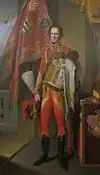 |
Ignác Gyulay (1763–1831) |
1806 | 1831 | Francis II (1792–1835) | |
 |
Franjo Vlašić (1766–1840) |
10 February 1832 | 16 May 1840 | Ferdinand V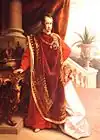 (1835–1848) | |
 |
Juraj Haulik (1788–1869) |
1840 | 16 June 1842 | Acting ban | |
 |
Franz Haller (1796–1875) |
16 June 1842 | 1845 | ||
 |
Juraj Haulik (1788–1869) |
1845 | 23 March 1848 | Acting ban |
Bans after the Revolutions of 1848
Croatia was a Habsburg crown territory during the Revolutions of 1848 and remained one up until 1867.[12]
| Portrait | Name (Birth–Death) |
Term start | Term end | Notes | Monarch (Reign) |
|---|---|---|---|---|---|
 |
Josip Jelačić (1801–1859) |
23 March 1848 | 19 May 1859 | Franz Joseph I_%E2%80%93_Hungarian_National_Museum.jpg.webp) (1848–1916) | |
.jpg.webp) |
Johann Baptist Coronini-Cronberg (1794–1880) |
28 July 1859 | 19 June 1860 | ||
 |
Josip Šokčević (1811–1896) |
19 June 1860 | 27 June 1867 |
Bans in Austria-Hungary
| Part of a series on |
| Great Officers of State in the Kingdom of Hungary |
|---|
.svg.png.webp) |
| Kingdom of Hungary |
Croatia was returned to Hungarian control in 1867 when the Habsburg Empire was reconstituted as the dual monarchy of Austria-Hungary. Between then and 1918 the following bans were appointed:
| Portrait | Name (Birth–Death) |
Term start | Term end | Notes | Monarch (Reign) |
|---|---|---|---|---|---|
 |
Levin Rauch (1819–1890) |
27 June 1867 | 26 January 1871 | Member of the Unionist Party that advocated for more integration of Croatia into Hungary. Notable for securing victory of the Unionist Party through changing the election law and terrorising those who were able to vote.[13] | Franz Joseph I_%E2%80%93_Hungarian_National_Museum.jpg.webp) (1848–1916) |
 |
Koloman Bedeković (1818–1889) |
26 January 1871 | 12 February 1872 | Bedeković was the leader of the Unionist Party and fought against Croatia's autonomy from Hungary. Dissatisfaction with the obstruction of parliament led to the Rakovica Revolt. Early elections were subsequently called for in 1872. The failure of Bedeković to convene the previous parliament resulted in him being removed from the post of ban and replaced with the first non-noble ban, Ivan Mažuranić. | |
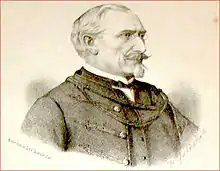 |
Antun Vakanović (1808–1894) |
17 February 1872 | 20 September 1873 | Acting ban | |
 |
Ivan Mažuranić (1814–1890) |
20 September 1873 | 21 February 1880 | Mažuranić was the first Croatian ban not to hail from old nobility, as he was born a commoner. He was a member of the People's Party. He accomplished the transition of Croatian lands from a semi-feudal legal and economic system to a modern civil society similar to those emerging in other countries in Central Europe. | |
 |
Ladislav Pejačević (1824–1901) |
21 February 1880 | 4 September 1883 | As the reincorporation of the Military Frontier into the Kingdom of Croatia-Slavonia was proclaimed on 15 July 1881, Pejačević was given the task to follow it through. On 1 August 1881, he took over the administration of the former Frontier. On 24 August 1883, he quit after the Council of Ministers in Vienna concluded that bilingual Hungarian official emblems, installed by Hungarian officials in Croatia-Slavonia, were not allowed to be removed from the official buildings and were to stay along the Croatian ones. | |
| Hermann Ramberg (1820–1899) |
4 September 1883 | 1 December 1883 | Acting ban | ||
 |
Karoly Khuen-Héderváry (1849–1918) |
4 December 1883 | 27 June 1903 | Khuen's reign was marked by strong Magyarization. After a series of riots broke out against him in 1903, Khuen was relieved of his duty and appointed prime minister of Hungary. | |
.jpg.webp) |
Teodor Pejačević (1855–1928) |
1 July 1903 | 26 June 1907 | At the beginning of the 20th century, he was faced with a new direction of Croatian policy marked by political alliance between Croats and Serbs in Austria-Hungary for mutual benefit. A Croat-Serb Coalition was formed in 1905, and it governed the Croatian lands from 1906 until the dissolution of the Dual Monarchy in 1918. As Pejačević supported the ruling Coalition in its resistance towards the Hungarian request in 1907 to make the Hungarian language an official language on railways in Croatia, he was forced to resign. | |
 |
Aleksandar Rakodczaj (1848–1924) |
26 June 1907 | 8 January 1908 | ||
 |
Pavao Rauch (1865–1933) |
8 January 1908 | 5 February 1910 | From the very beginning of Rauch's rule, the Croato-Serbian Coalition announced that it would refuse to co-operate in any manner with the new unionist ban.[14] After the Croatian Parliament had been disbanded on 12 March 1908, because of its refusal to co-operate and the insults it directed at the ban, Pavao Rauch ruled through decrees and civil servants. Despite all opposition predictions, Rauch remained in power for two years. On 5 February 1910, he received the king's letter of dismissal. | |
 |
Nikola Tomašić (1864–1918) |
5 February 1910 | 19 January 1912 | ||
 |
Slavko Cuvaj (1851–1931) |
19 January 1912 | 21 July 1913 | He was appointed in January 1912, when anti-Habsburg sentiments were on the rise in Croatia, often manifesting in sympathies for Serbia and calls for creation of a Yugoslav state. Cuvaj tried to curb those trends by series of decrees directed at curbing the freedom of the press, limiting rights of assembly and local autonomy. This created a backlash in the form of strikes and demonstrations. Some young radicals even engaged in terrorism. Cuvaj himself was target of two assassination attempts in 1912. | |
 |
Ivan Skerlecz (1873–1951) |
27 November 1913 | 29 June 1917 | Skerlecz managed to reconvene the Croatian Parliament in Zagreb by 1915. The Croats made further demands for local authority, as well as unification of Croatia-Slavonia with Dalmatia and Bosnia and Herzegovina. | |
Charles IV (1916–1919) | |||||
 |
Antun Mihalović (1868–1949) |
29 June 1917 | 20 January 1919 |
Croatian bans in the Kingdom of Yugoslavia
Ban was also the title of the governor of each province (banovina) of the Kingdom of Yugoslavia between 1929 and 1941. The weight of the title was far less than that of a medieval ban's feudal office. Most of Croatian territory was divided between the Sava and Littoral Banovina, but also some parts were outside this provinces.
In 1939 Banovina of Croatia was created with Cvetković-Maček agreement as a unit of limited autonomy. It consisted of the Sava and Littoral Banovinas along with smaller parts of Vrbas, Zeta, Drina and Danube Banovina's. Ivan Šubašić was appointed for the Ban of Banovina of Croatia until the collapse of Kingdom of Yugoslavia in 1941. Šubašić was also the last person who held the position of Croatian Ban.
Bans within the Kingdom of Serbs, Croats and Slovenes
Following a brief period of self-rule at the end of World War I, Croatia was incorporated into the Kingdom of the Serbs, Croats and Slovenes in 1918, under the Karađorđević dynasty.
| Portrait | Name (Birth–Death) |
Term start | Term end | Notes | Monarch (Reign) |
|---|---|---|---|---|---|
 |
Ivan Paleček (1868-1945) |
20 January 1919 | 24 November 1919 | Peter I (1918–1921) | |
 |
Tomislav Tomljenović (1877-1945) |
24 November 1919 | 22 February 1920 | ||
.jpg.webp) |
Matko Laginja (1852–1930) |
22 February 1920 | 11 December 1920 | ||
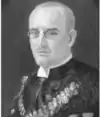 |
Teodor Bošnjak (1876-1942) |
23 December 1920 | 3 July 1921 | ||
 |
Tomislav Tomljenović (1877-1945) |
2 March 1921 | 2 March 1921 |
Bans of the Sava Banovina
In 1929, the new Constitution of the Kingdom renamed it Kingdom of Yugoslavia and split up the country into banovinas.
| Portrait | Name (Birth–Death) |
Term start | Term end | Notes | Monarch (Reign) |
|---|---|---|---|---|---|
 |
Josip Šilović (1858–1939) |
3 October 1929 | 1931 | Alexander I (1921–1934) | |
| Ivo Perović (1881–1958) |
1931 | 1935 | |||
 |
Marko Kostrenčić (1884–1976) |
1935 | 1936 | Peter II (1934–1941) | |
 |
Viktor Ružić (1893–1976) |
1936 | 1938 | ||
 |
Stanoje Mihaldžić (1892–1941/1956) |
1938 | 26 August 1939 |
Bans of the Littoral Banovina
| Portrait | Name (Birth–Death) |
Term start | Term end | Notes | Monarch (Reign) |
|---|---|---|---|---|---|
 |
Ivo Tartaglia (1880–1949) |
1929 | 1932 | Alexander I (1921–1934) | |
| Josip Jablanović (1875–1961) |
1932 | 1935 | |||
| Mirko Buić (1894–1967) |
1935 | 26 August 1939 | Peter II (1934–1941) |
Bans of the Banovina of Croatia
In 1939, the Banovina of Croatia was created with Cvetković-Maček agreement as a unit of limited autonomy within Kingdom of Yugoslavia. It consisted of the Sava and Littoral Banovinas along with smaller parts of Vrbas, Zeta, Drina and Danube Banovinas.
| Portrait | Name (Birth–Death) |
Term start | Term end | Notes | Monarch (Reign) |
|---|---|---|---|---|---|
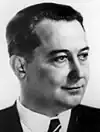 |
Ivan Šubašić (1892 –1955) |
26 August 1939 | 10 April 1941 | Last person to hold the title of ban. | Peter II (1934–1941) |
See also
References
- ↑ De Administrando Imperio 30/90-117, "καὶ ὁ βοάνος αὐτῶν κρατεῖ τὴν Κρίβασαν, τὴν Λίτζαν καὶ τὴν Γουτζησκά"
- ↑ "Pribina | Proleksis enciklopedija". proleksis.lzmk.hr. Retrieved Dec 4, 2022.
- ↑ hr:s:Povijest Hrvatske I. (R. Horvat)/Nasljednici kralja Tomislava
- ↑ Comperimus namque in gestis proaui nosti Cresimiri maioris... Stipišić, J. i M. Šamšalović, ur. Codex Diplomaticus Regni Croatiae, Dalmatiae et Slavoniae, sv. 1. Zagreb: Izdavački zavod JAZU, 1967., pp. 105.
- ↑ Rački, Documenta, 472.
- ↑ Comperimus namque in gestis proaui nosti Cresimiri maioris... Stipišić, J. i M. Šamšalović, ur. Codex Diplomaticus Regni Croatiae, Dalmatiae et Slavoniae, sv. 1. Zagreb: Izdavački zavod JAZU, 1967, pp. 105.
- ↑ R. Horvat - Povijest Hrvatske I.
- ↑ Tomislav Raukar, Hrvatsko srednjovjekovlje, Školska Knjiga, Zagreb, 1997 pp. 47-48
- ↑ "Monumenta antiquissima". Archived from the original on 2016-03-03. Retrieved 2016-03-16.
- ↑ John Van Antwerp Fine: The Early Medieval Balkans: A Critical Survey from the Sixth to the Late Twelfth Century, 1991, p. 279
- ↑ Neven Budak: Prva stoljeća Hrvatske, Hrvatska sveučilišna naklada, Zagreb 1994, p. 31-33
- ↑
- ↑ Sirotković, Hodimir; Margetić, Lujo (1988). Povijest država i prava naroda SFR Jugoslavije (in Croatian). Školska knjiga. p. 148. ISBN 9788603991802.
- ↑ Kolar, Mira (Dec 15, 2005). "The Activities of Vice-Roy Pavao Rauch In Croatia". Review of Croatian History. I (1): 133–158. Retrieved Dec 4, 2022 – via hrcak.srce.hr.
External links
- "Bans of Croatia and Dalmatia (style Ban Hrvatske i Dalmacije)" at World Statesmen.org

